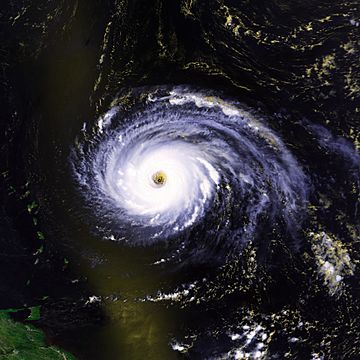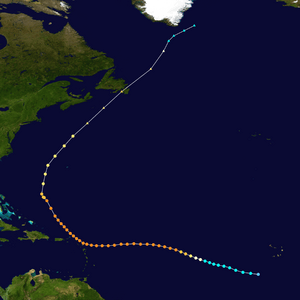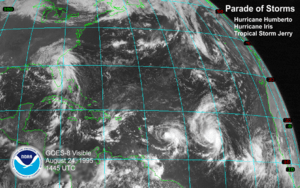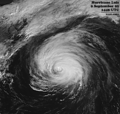Hurricane Luis facts for kids
| Category 4 major hurricane (SSHWS/NWS) | |

|
|
| Formed | August 27, 1995 |
|---|---|
| Dissipated | September 11, 1995 |
| Highest winds | 1-minute sustained: 150 mph (240 km/h) |
| Lowest pressure | 935 mbar (hPa); 27.61 inHg |
| Fatalities | 17 direct |
| Damage | $2.7 billion (1995 USD) |
| Areas affected | Bermuda, Leeward Islands, Newfoundland (Canada), United States |
| Part of the 1995 Atlantic hurricane season | |
Hurricane Luis was a very strong storm during the busy 1995 Atlantic hurricane season. It was the second most powerful hurricane that year, right after Hurricane Opal. Luis was the strongest storm to hit the Leeward Islands since Hurricane Hugo in 1989. At one point, five storms were active at the same time! Many areas hit by Luis had just been damaged by Hurricane Iris. Some islands were even hit again by Hurricane Marilyn soon after.
Contents
How Hurricane Luis Formed and Traveled
Hurricane Luis started as a tropical wave. This wave moved off the coast of Africa on August 26. The next day, it became Tropical Depression Thirteen near Cape Verde. On August 29, it grew stronger and was named Tropical Storm Luis.
Luis became a hurricane on August 30. By September 2, it had become a very powerful Category 4 hurricane. On September 3, Luis reached its top strength. Its winds blew at 150 miles per hour. This made it a strong Category 4 hurricane.
Luis continued moving west. It passed over Barbuda late on September 4. It also came very close to Antigua, St. Barthelemy, St. Martin, and Anguilla.
The storm then turned northwest. Luis weakened to a Category 2 hurricane while it was 150 miles north of Puerto Rico. It had been a major hurricane for a whole week. Luis slowly kept getting weaker as it moved northeast.
While Luis was near Newfoundland, Canada, it caused a giant wave. This wave was over 98 feet tall! Luis made landfall in eastern Newfoundland on September 11. It was a Category 1 hurricane at that time. On the same day, Luis changed into a different type of storm. It then disappeared near Greenland.
Where Hurricane Luis Caused Damage
Hurricane Luis impacted many places. Many islands had just been hit by Hurricane Iris a week before. Sadly, many were also hit by Hurricane Marilyn just ten days later.
Impact on Antigua and Barbuda
Luis caused a lot of damage in Antigua and Barbuda. This was because the hurricane passed directly over the country. In Antigua, about half of the houses were either destroyed or badly damaged. In Barbuda, nearly 70% of homes were destroyed or damaged. The government spent about $350 million U.S. Dollars to fix everything.
Impact on Bermuda
In Bermuda, winds reached about 46 miles per hour. However, there was no damage or loss of life in Bermuda. On September 11, a large ship called the Queen Elizabeth 2 got caught in the 98-foot wave caused by Luis. The ship was not damaged, but it arrived late in New York.
Impact on Canada
The only part of Canada affected by Luis was Newfoundland.
Damage in Newfoundland
In Newfoundland, one person died because of Luis. The storm caused about $500,000 in damage. Luis dropped between 2.4 and 4.7 inches of rain as it passed over Newfoundland on September 11.
Impact on Dominica
In Dominica, large waves from Hurricane Luis caused one fisherman to die. Hurricane Luis caused about $47 million in damage to this island nation.
Impact on St. Martin
St. Martin, a small island, was hit hardest by Luis. Even though Luis did not directly hit St. Martin, it caused a lot of harm. Nine people died, and the island had $1.8 billion in damage.
Impact on the United States
In North Carolina, a U.S. state, a large wave caused one person to die. In New York, a wave washed under a house. This house was later destroyed, causing $1.9 million in damage.
Other Affected Areas
In Guadeloupe, one person died because of Luis. In Saint Barthelemy, winds were recorded up to 155 miles per hour. In Saint Kitts and Nevis, damages from Luis were about $197 million.
After the Storm: Recovery and Records
After Hurricane Luis, many groups and governments gave money. This money helped to fix the damage on the affected islands. The largest donation came from the Government of the Netherlands, which gave $15.2 million.
Interesting Records Set by Luis
When Tropical Depression Thirteen became Tropical Storm Luis on August 29, it was the earliest date for the 12th named storm of a season. As Luis was changing into a different type of storm, it sped up to nearly 65 miles per hour. This made it the third fastest-moving Atlantic hurricane ever.
On September 11, Luis caused that huge 98-foot wave. This was the highest wave ever recorded from an Atlantic hurricane at the time. However, in 2004, Hurricane Ivan might have caused an even bigger wave, possibly up to 130 feet.
Why the Name Luis Was Retired
The name Luis was removed from the list of hurricane names in the spring of 1996. This means the name Luis will never be used again for a hurricane. This happens when a storm causes a lot of damage or loss of life. Luis was the first name retired since Andrew in 1992. It was also the first hurricane name starting with 'L' to be retired. Now, Luis is one of only two 'L' names retired. The other is Lili from 2002. In 2001, the name Lorenzo was used instead of Luis.
|
Tropical cyclones of the 1995 Atlantic hurricane season |
|||||||||||||||||||||||||||||||||||||
|
|
||||||||||||||||||||||||||||||||||||
|
|
|||||||||||||||||||||||||||||||||||||
Images for kids
-
Hurricane Luis on September 6 to the north of the Leeward Islands







